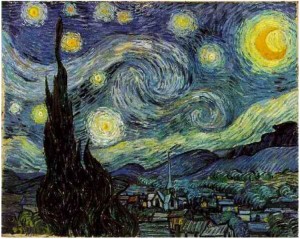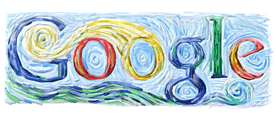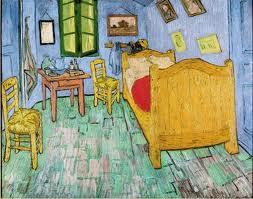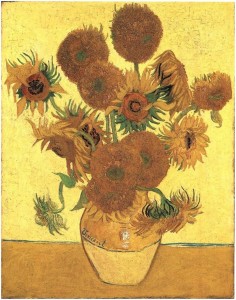Vincent Van Gogh Google Doodle: The Starry Night
Vincent Van Gogh Google Doodle

Back in 2005, the Google doodle team celebrated with a Vincent Van Gogh Google Doodle on what would have been the 152nd birthday of the talented artist. The Vincent Van Gogh Google Doodle appeared on the search engine’s homepage on March 29th.
The minimalist Google logo was incorporated into the Dutch painter’s sweeping brush strokes in order to create a Google version of Van Gogh’s famous painting “The Starry Night” in the Vincent Van Gogh Google Doodle.
The dedicated Vincent Van Gogh Google Doodle appeared on the search engine’s homepage globally during March 29th 2005.

In the Vincent Van Gogh Google Doodle, the Google logo appeared in its trademark colour scheme of red, blue, green and yellow in its usual font type. However, in the Vincent Van Gogh Google Doodle the font was represented in Vincent Van Gogh’s trademark brush style. A yellow swirl merged into the second “O” of the logo of the Vincent Van Gogh Google Doodle, similar to the swirls which appear in his iconic work “The Starry Night”.
Vincent Willem Van Gogh was born in the village of Groot-Zundert, in the Netherlands on March 30th 1853. His father, Theodurus Van Gogh was a minister for the Dutch Reformed Church. It was noted that as a child Vincent was serious, still and thoughtful. For the first year of his education, 1860, Vincent was taught at the local village school. However from 1861 onwards, Vincent was educated at home with his sister by a governess. This continued until 1864, when Vincent was sent to Jan Provily’s boarding school. The school was situated in Zevenbergen, 20 miles away from the family home, the move caused him much distress.
His passion for art began at an early age, he spent much of his childhood drawing, before deciding to become an artist. His early drawings were both technically good and impressive, however they lacked the intensity of his later work. He was helped to achieve his artistic dreams by his uncle, Cent, who assisted the young Vincent in obtaining a position with the art dealer Goupil and Cie in The Hague.
Once he had finished his training Van Gogh was sent to London, England. Here he worked at Messer Goupil and Co., he gained early success in his position and by the age of twenty he was earning more than his father. His happiness did not last as he complained of becoming increasingly isolated. His father and uncle arranged for Vincent to work in Paris. However he became increasingly disillusion with commercial art, as he felt that it was treated as a commodity to attract customers. Goupil ended his employment on April 1st 1870.
Following the termination of his employment at Goupil, Van Gogh spent a period of time working as an unpaid supply teacher in England. Before deciding to become assistant to a Methodist minister, during this period he went through a strong religious revival and went to study theology at Amsterdam in 1877. However his ambitions were thwarted when he failed the univerity’s entrance examination.
Van Gogh was introduced to both oil and watercolour painting by his cousin-in-law, Anton Mauve, who was a realist painter. Anton Mauve lent Van Gogh money to set up an art studio, the two later fell out, after which Anton was cold toward Van Gogh. It is thought that the change in temperament was attributed to Anton’s discovery of Vincent’s living arrangements. At the time Van Gogh was living with the alcoholic prostitute Clasina Maria “Sien” Hornick and her daughter.
After substantial pressure from his father, Vincent left Sien in the autumn of 1853 after a year together. Sien’s turbulent life ended in 1904 when she committed suicide by drowning herself in the River Scheldt. During 1853 Van Gogh’s uncle commissioned Vincent to create twelve ink drawings of views of The Hague. These were quickly completed and during the summer he started to paint with oil.
In 1883 Van Gogh moved to Neunen where he met Margot Bergemann, in the autumn of the following year. The two fell in love and became engaged, however the marriage never occurred due to fierce resistance from the couples parents. Following this Margot attempted to commit suicide by taking an overdose of strychnine. The attempt was unsuccessful as Vincent found her and rushed Margot to hospital.
By Spring 1885 he had completed what is widely accepted as his first body of work, “The Potato Eaters”, which was the culmination of several year’s work capturing peasant character studies. The collection was his first to be exhibited and appeared in the windows of the paint dealer Leurs in The Hague during August 1885.
The paintings from this period, which include “Still-life with Straw Hat and Pipe” and “Still-life with Earthen Pot and Clogs”, feature the fine shading of colours and are characterised by smooth meticulous brush strokes. Towards the end of 1885, Van Gogh moved to Antwerp, here he began drinking absinthe heavily. Whilst here he extended his pallet, which had previously been limited to earthy tones, he introduced carmine, cobalt and emerald green. However due to overworking and excessive smoking, linked to malnutrition Van Gogh became extremely unwell for most of February 1886.
In March 1886, Van Gogh moved to Paris. Here he painted “Portrait of Père Tanguy” in 1887, “The Courtisan” in 1887 and “Plum Tree in Blossom” in 1888. After viewing the work of Adolphe Joseph Thomas Monticelli, he began to use brighter colours and a bolder style. This influence can be seen in “Seascape at Saintes-Maires”, created in 1888.

Between the years 1888 and 1889 Van Gogh lived in Arles. Whilst here he painted a series of paintings including, “Van Gogh’s Chair”, “Bedroom in Arles”, “Night Café”, “Café Terrace at Night”, “Starry Night Over the Rhone” and “Still Life with Twelve Sunflowers”.
All of these paintings were completed during 1888.
Whilst in Arles, Van Gogh famously cut off his left ear. It is unknown exactly why he did this although historians attribute it to quarrels with his friend Gauguin and fears that he was going to leave. Van Gogh severed his ear on the evening of December 23rd 1888. He placed his ear in a parcel and delivered it to a brothel which himself and Gauguin frequented. Following the delivery he returned home, collapsed and was discovered by the police who took him to hospital. Van Gogh claimed to have no memory of these events and historians believe he suffered from an acute psychotic episode. Within a few days he was sectioned, however he made a speedy recovery despite being diagnosed with general delirium and returned home early in January 1889.
Following his stint in Arles, Van Gogh lived in Saint-Rémy, for a year between May 1889 and May 1890. During this time he completed a large amount of artwork including one of his most famous paintings “The Starry Night”, which formed the basis for the Vincent Van Gogh Google Doodle. Other paintings completed during this period include, “Sorrowing Old Man” 1890, “Two Peasant Women Digging in a Snow Covered Field at Sunset” 1890 and “The Round of the Prisoners” also completed in 1890.
Whilst in Saint-Rémy, Van Gogh went on a number of supervised walks in the surrounding countryside. These walks served as the inspiration for a number of paintings which featured cypresses and olive trees, including, “Olive Trees with the Apilles in the background”, 1889.
On February 22nd 1890 Van Gogh suffered from a crisis which was to last until April, during this time he was unable to write but still continued to paint and draw. It is believed that Van Gogh shot himself in the stomach with a revolver, although the gun was never found. However some sources argue that he did not shoot himself and was shot instead by accident by two boys who had a malfunctioning gun. The shot wasn’t fatal in of itself, however the two local doctors who treated him were unqualified to remove the bullet through surgery. As a result he died on July 27th 1890, aged just 37.
Van Gogh is not the only painter to have their life’s achievements celebrated with a Vincent Van Gogh Google Doodle, in their unique artistic style. These painters include Rembrandt van Rijn, Pablo Picasso and Claude Monet.

